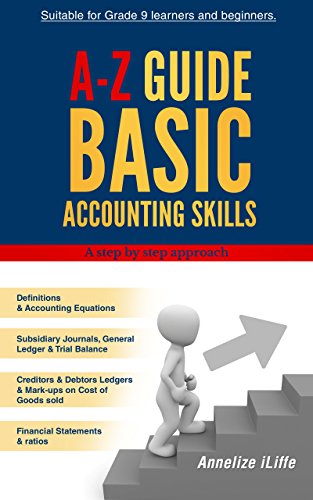
A-Z Guide Basic Accounting Skills : Annelize Iliffe
 A-Z Guide Basic Accounting Skills
A-Z Guide Basic Accounting Skills
This A-Z Accounting guide is specifically written for Grade 9 learners and beginners. It is a continuation of the Grade 8 e-book Learning your Accounting basics.
The resource is written in simple English, is user-friendly and the concepts link together to enable the reader to move successfully onto the next section.
The Grade 8 e-book is based on a story of a girl who started a Sweets Business and the underlying Accounting concepts and skills necessary to succeed in this.
Grade 9 is a continuation of Grade 8, and is linking the concepts learnt from Grade 8 to Grade 9 in story format, through the transactions.
The e-book can be used by all Educators who are teaching Accounting or EMS, and sections or topics can be covered to suit the specific lesson plans or needs in the classroom.
The e-book is written in a one concept per page format, is colourfully illustrated and takes the user step by step through the process of learning Accounting. It is written in such a way to enable the learner to practise while learning the concepts.
ALSO SUITABLE FOR ALL BEGINNERS OF ALL AGES WHO WANT TO LEARN ACCOUNTING AND HAS TO FINANCE BACKGROUND.
It covers all the basic concepts including:
1) Introduction, theory and accounting equations. Definitions, illustrations and equations with lots of practical examples are covered in these sections.
2) Cash and credit journals (books of first entry). Compiling of the journals are shown step by step, and source documents are linked to each page, showing the importance and relevance of these documents. The double entry principle is clearly illustrated, using colors.
3) Posting to the General Ledger (step by step instruction on how to post, the relevance of columns in the journals and how to distinguish debits and credits in the ledger, contra accounts and their meaning, folios and cross references are explained in detail. The use and meaning of Analysis of Receipts and Sundry accounts column) are covered.
4) Balancing the ledger accounts. Steps are clearly explained and illustrated. Different scenarios of balancing a ledger account are covered.
5) Preparing a Trial Balance. Detailed illustrations of each entry from the General Ledger, and finally the full Trial Balance is shown how it is balanced.
4) Debtors Ledger (Accounts Receivable Ledger), Debtors Control (Accounts Receivable Control) and Introduction to Bank Statements. This section is illustrated and explained in great detail with examples. The general ledger is taken step by step and the effects of each entry is illustrated. Lots of examples will ensure understanding of the concepts. Bank statement and comments are highlighted, ensuring that the user is grasping the principles taught which lays the foundation for further bank reconciliations.
5) Creditors Ledger (Accounts Payable Ledger) and Creditors Control (Accounts Payable Control). As with the Debtors Ledger and Debtors Control, this section is covered in great detail with illustrations and examples to facilitate understanding and grasping of the topics.
6) Petty cash. Accounting equations of the transactions, entering each transaction in the Petty Cash Journals, showing the cumulative entries, posting to the Ledger, and detailed illustrations of restoring Petty Cash. Source documents are also shown.
7) Mark-ups and gross profit percentages. Relationship between Sales, Gross Profit and mark-up. Illustrations and examples to illustrate these important accounting concepts.
8) Income Statement (Statement of Comprehensive Income). Definitions, illustrations and step by step instruction on how to prepare the Income Statement.
9) Balance Sheet (Statement of Financial Position). Balance Sheet and Notes are shown step by step on how to do, and how it is interlinked.
10) Ratios and Interpretation of Financial Statements. Illustrations explaining the relevance of the figures, and the relationship of these elements and their meaning.
Book Links
Website
Facebook
Linkedin
Books2Read
On Amazon












